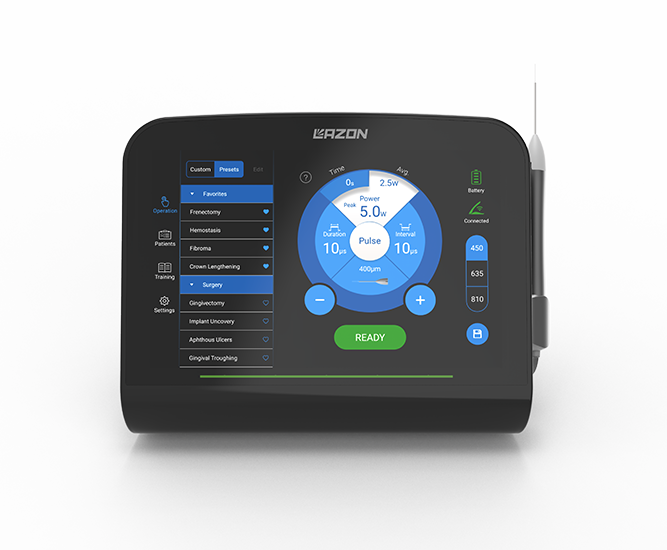In the past two decades, Dental Diode Lasers have been widely used in the dental field, wavelengths primarily in the near infrared spectrum (NIR, 800–1,000 nm). The main applications include cutting and removing oral soft tissues, disinfecting gum pockets and root canals, biostimulation to accelerate wound healing and assist in tooth whitening. The biggest advantage of diode laser is its low price and easy to use. It is friendlier for beginners.

With the continuous development of industrial technology, the emission spectrum of laser diodes has gradually expanded. In the past few years, the blue-spectrum laser diode system has been realized at the technical level and has been gradually applied in clinical practice. From a biomedical point of view, this blue wavelength has significant advantages over traditional infrared wavelengths in some respects, while maintaining the inherent diode laser advantages.
The main advantages of 450nm Blue Dental Diode Laser include very high cutting efficiency at lower power settings, less side effects of thermal damage, good wound healing effects, and better disinfection effects. From the current point of view, the 450 nm dental laser does not have any particularly obvious shortcomings.
In the surgical operation of oral soft tissue (incision/resection) with the 450 nm blue laser, due to a higher level of absorption in melanin and hemoglobin, the user can use a lower power setting with 450nm to achieve the same cutting effect as a high-power near-infrared laser. Experiments have shown that the cutting effect of a 450nm laser using 320μm in a continuous mode of 2W power is almost the same as that of a 980nm laser in a continuous mode of 3W in a pig jaw. 450nm laser demonstrated good cutting effectiveness and hemostasis, tissue vaporization begins immediately after activating the laser. The working area remained clear due to hemostasis. No mechanical effects (clefts/tissue deformation) were observed. The carbonizing layer on the tissue surface treated is very narrow. Vessels in this area display no ruptures. No red blood cells were detected outside of the vessels in the tissue.

According to experiments, the healing process after cutting with 450nm or 980nm laser is comparable to the mechanical injury healing process. And there is no evidence that the incidence of cell double-strand breaks increased after 450nm laser system surgery. Contrary to UV radiation, 450nm and 980nm laser radiation does not increase the risk of DNA damage.
The antimicrobial effect of laser is based on thermal and photochemical effects, such as known from aPDT (antibacterial photodynamic therapy). Basic medical research shows that blue light also has antimicrobial effects. Experiments have shown that under certain test conditions, using 450nm blue laser even at low output power (0.1 W) in non-contact mode with 320μm fiber tip, the antimicrobial effect is also demonstrated. And compared with infrared laser irradiation, the thermal influence on the irradiated area is very low.

Due to the strong absorption of blue laser in hemoglobin, 450nm laser has obvious coagulation effect. Even used with an output power of 0.1 W in continuous mode, Irradiation with a 320μm fiber tip at a distance of 10 mm from the tissue will cause a clearly visible coagulation effect very quickly. This hemostatic effect provides sustainable support for incision and excision, especially for patients with anticoagulation therapy.
450nm wavelength laser has been a popular product in recent years, and its excellent cutting effect allows dentists to obtain better treatment results by using dental diode lasers. It can be predicted that 450nm will become one of the indispensable wavelengths in the design of multi-wavelength dental diode lasers in the future.